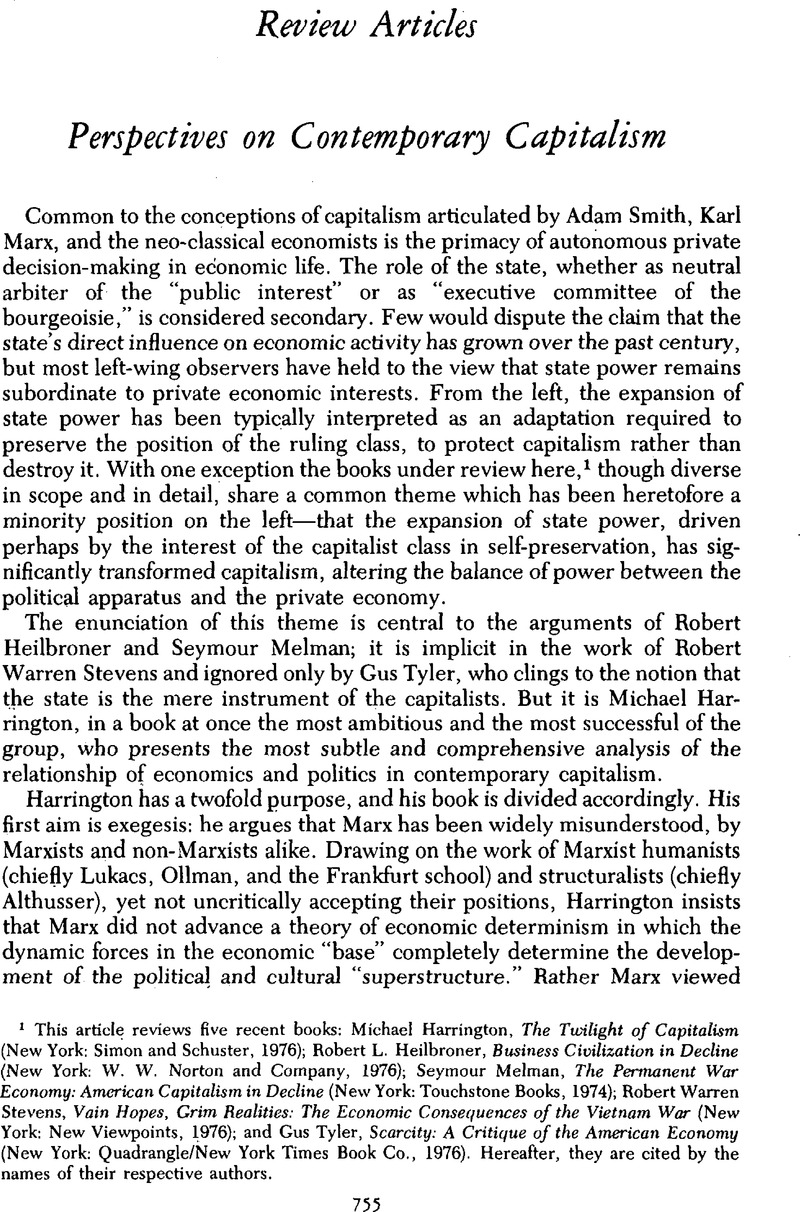No CrossRef data available.
Published online by Cambridge University Press: 11 May 2010

1 This article reviews five recent books: Harrington, Michael, The Twilight of Capitalism New York: Simon and Schuster, 1976)CrossRefGoogle Scholar; Heilbroner, Robert L., Business Civilization in Decline New York: W. W. Norton and Company, 1976)Google Scholar; Melman, Seymour, The Permanent War Economy: American Capitalism in Decline (New York: Touchstone Books, 1974)Google Scholar; Stevens, Robert Warren, Vain Hopes, Grim Realities: The Economic Consequences of the Vietnam War (New York: New Viewpoints, 1976)Google Scholar; and Tyler, Gus, Scarcity: A Critique of the American Economy New York: Quadrangle/New York Times Book Co., 1976)Google Scholar. Hereafter, they are cited by the names of their respective authors.
2 While there is textual evidence to support this view of Marx, the “pervasive lighting” metaphor repeatedly cited by Harrington does not refer to the relation between economic forces and political, social, and cultural developments. Rather, Marx uses the metaphor to illustrate how a specific, predominant form of production (e.g., agriculture in feudal society, industry in bourgeois society) relates to co-existing forms of production. Compare Harrington, p. 66, and Marx, Karl, A Contribution to the Critique of Political Economy, translated by Stone, N. I. (Chicago: Charles H. Kerr and Company, 1904), pp. 302–4Google Scholar.
3 The 1859 preface contains the familiar summary statement of Marx's theory of historical development:
The mode of production in material life determines the general character of the social, political, and spiritual processes of life. It is not the consciousness of men that determines their existence, but, on the contrary, their social existence determines their consciousness. At a certain stage of their development the material forces of production in society come into conflict with the existing relations of production, or what is but a legal expression for the same thing—with the property relations within which they had been at work before. From forms of development of the forces of production these relations turn into their fetters. Then comes the period of social revolution. With the change of the economic foundation the entire immense superstructure is more or less rapidly transformed. …
4 Harrington, p. 37.
5 Ibid., p. 41.
6 For example, Okun, Arthur M., The Political Economy of Prosperity (New York: W. W. Norton, 1970)Google Scholar; and Silk, Leonard, Nixonomics (New York: Praeger, 1972)Google Scholar.
7 Friedman, Milton, “Monopoly and the Social Responsibility of Business and Labor,” in Capitalism and Freedom (Chicago: University of Chicago Press, 1962), pp. 119–36Google Scholar.
8 One example conveys the flavor of Tyler's relentless search for the demon monopoly. He suggests that the increases in fertilizer prices in 1974 were perpetrated by a conscious conspiracy of fertilizer producers vertically integrated into cotton production in order to induce the federal government to raise the cotton support price. Tyler fails to observe that the fertilizer industry is relatively unconcentrated, many fertilizer producers do not grow cotton, and many fertilizers are produced from petrochemical feedstocks, so that the price of fertilizer is not unrelated to the price of oil.
9 Bell, Daniel, The Coming of Post-Industrial Society (New York: Basic Books, 1973)Google Scholar.
10 Barnet, Richard and Müller, Ronald, Global Reach (New York: Simon and Schuster, 1974)Google Scholar.